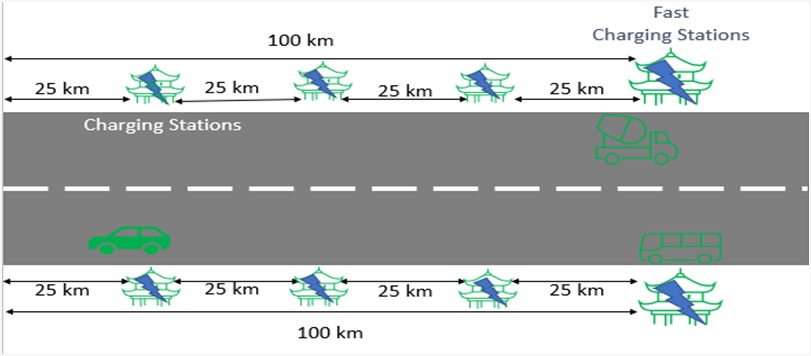ELECTRIFICATION OF TRUCKS FOR CEMENT SECTOR IN INDIA
EXISTING POLICIES FOR ELECTRIC VEHICLE AND POLICY SUPPORT REQUIRED FOR E-TRUCKS ADOPTION IN CEMENT SECTOR
The Government of India (GOI) has implemented several initiatives aimed at fostering a sustainable and clean transportation system through the adoption of electric vehicles (EVs). These policies support the development of infrastructure, purchase, and use of EVs across the nation.
Existing National Level Policy in India
The central government of India has announced several promotional initiatives over the past ten years to accelerate the adoption of electric vehicles (EVs). The major initiatives include tax breaks for EV owners and the expansion of public EV charging infrastructure. The timeline for various initiatives taken by policymakers has been illustrated below.
Over the past decade, the central government has introduced various promotional initiatives to accelerate EV adoption:
- National Electric Mobility Mission Plan (NEMMP): Launched in 2013 by the Department of Heavy Industry (DHI), targeting 6-7 million EV sales by 2020 to enhance national fuel security.
- FAME India Scheme (Faster Adoption and Manufacturing of Electric Vehicles in India): FAME India is a flagship program which aimed at promoting the adoption of electric and hybrid vehicles in the country. It provides incentives for purchasing electric vehicles and supports the establishment of charging infrastructure. This flagship program is divided into two phases:
- FAME I: Started in April 2015, focusing on demand creation, technology platforms, pilot projects, and charging infrastructure, extended until March 2019.
- FAME II: Launched in April 2019 with a budget of ₹10,000 crore over three years to support the purchase of various types of electric vehicles.
- State EV Policies: Notified in 28 states, offering incentives like subsidies and tax exemptions to boost EV adoption.
- GST Rate Reduction: Lowered from 12% to 5% to make EVs more affordable.
- Charging Infrastructure Development: Focus on establishing charging stations along major highways.
- Custom Duty Reduction: Reduced duties on parts used in EV manufacturing to lower costs and promote domestic production.
The Go Electric campaign, the Shoonya campaign, and the exemption of registration fees for electric vehicles are just a few of the additional initiatives that actively support the EV ecosystem in India.
EV Charging Infrastructure in India
In 2018, the Ministry of Power set regulations for public charging infrastructure, requiring a minimum density of charging stations along highway corridors and urban areas. EV charging has been deregulated, allowing more private investment.

Policy support required for electric truck adoption:
To accelerate the adoption of E-trucks in the cement sector, further supportive measures are essential:
- Extend FAME Policy Subsidies: Currently targeted primarily at personal and light commercial vehicles, extending these to E-trucks would boost their adoption in heavy industries like cement.
- Develop Specific Incentives for Retrofitting: Promote the conversion of existing ICE trucks to electric with targeted incentives.
- Enhance Driver and Fleet Owner Benefits: Implement policies that provide direct benefits to operators, such as reduced toll charges and favorable insurance and loan terms.
- Battery Replacement Subsidy: Introduce subsidies specifically for battery replacements in E-trucks.
- Support for Battery Manufacturers & Recyclers: Strengthen the battery manufacturing and recycling sectors with targeted policies.
- Promote Renewable Energy at Charging Stations: Incentivize the use of renewable energy for powering EV charging stations.
- Standardized Charging Protocols: Establish uniform standards for charging systems to streamline operations and reduce costs.
These targeted policies are crucial for addressing the specific needs and challenges of deploying heavy-duty E-trucks in sectors like cement, aiming to achieve broader environmental and economic goals.
As the adoption of electric trucks and tippers gradually increases across the cement sector, a coordinated approach involving all stakeholders—end users, technology providers, and policymakers—is essential to accelerate this transition. Here are some strategic recommendations to enhance the adoption of electric vehicles (EVs) in the industry:

- Mandate Green Financing: Encourage banks to offer green loans at reduced rates through mandatory policy measures.
- Insurance Guidelines: Implement favorable insurance guidelines to mitigate risks associated with electric vehicle investments.
- Extended Vehicle Loan Period: Consider extending vehicle loan periods to 8-10 years from the current norm of 4 years to ease financial burdens and stimulate purchases.

To accelerate electric Truck adoption in cement sector, policy support is required for expanding FAME policy subsidies to encompass commercial EVs, introducing subsidized toll charges for EVs, implementing battery replacement subsidies, supporting domestic battery manufacturing and recycling industries, and subsidizing power generation costs at charging stations. Furthermore, offering incentives in carbon trading policies for E Truck adopting organizations and establishing standardized charging protocols, including battery swapping systems, are recommended to enhance EV infrastructure and promote widespread adoption across the sector.

- Faster Approval from State Electricity Boards: Streamline the process for setting up charging infrastructure by ensuring faster approvals from state electricity boards.
- Faster RTO Registration: Facilitate quicker registration processes through Regional Transport Offices (RTOs) for EVs.
- Special Category Status: Grant special category status to commercial EVs to avail various benefits, such as expedited services and exemptions.
- Scaling Up Charging Infrastructure: Urgently expand charging infrastructure along cement freight corridors.
- Payload Compensation/Relaxation: Offer payload compensation or relaxation in line with battery weight.

- Long-term Contracts & Remuneration Increment for Crew: Accelerate E-truck adoption by logistic service providers.
- Charging Infrastructure at Plant Premises: Utilize renewable power to decrease the vehicle payback period.
- Green Channel for E-Trucks: Facilitate a higher number of trips.
- Priority-Based Loading of E-Trucks: For short distances or direct dispatch.
- Bulk Loading/Other Mechanized Loading Systems: Reduce loading time for raw material handling E-trucks.
- Exploration of Battery Swapping Technologies Reduce charging time and the requirement for en-route charging infrastructure.

